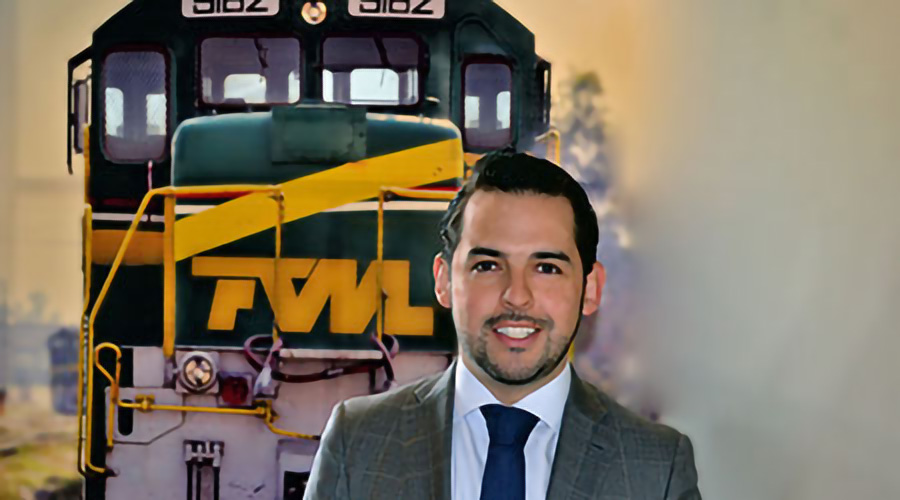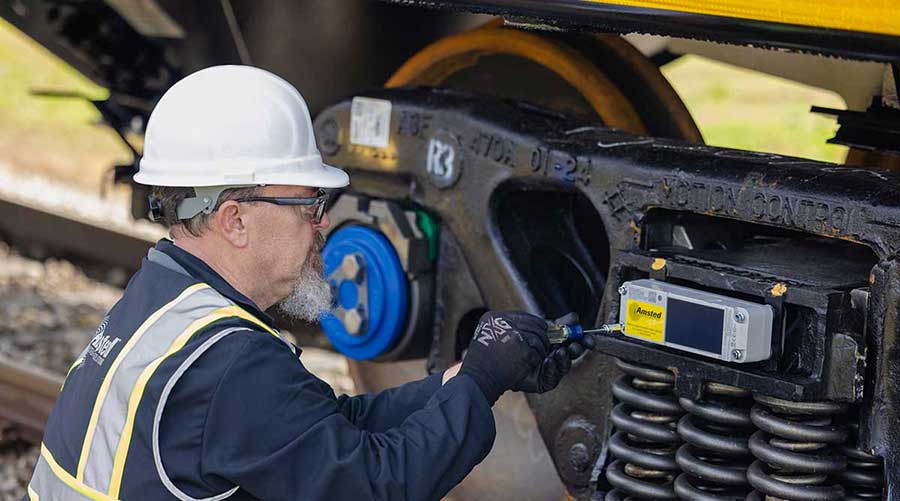Stay updated on news, articles and information for the rail industry
September 2020
Rail News: Rail Industry Trends
Rising Stars share opinions on railroading’s top challenges

By Julie Sneider, Senior Associate Editor
What are the railroad industry’s greatest challenges today, and what will they be in the future?
That’s what Progressive Railroading recently asked the young professionals who the magazine selected as recipients of this year’s Rising Stars Award. Their answers touched on a range of topics, from technology and automation, to workforce recruitment and retention, to competition and customer service.
And though they come from different perspectives as a result of their career experiences, many of these up-and-coming industry leaders also agree that rail-related businesses will have to confront a new layer of challenges due to fallout from the COVID-19 pandemic.
Following are the Rising Stars’ responses.
Maeghan Albiston, assistant vice president of investor relations and pensions at Canadian Pacific: "Disruption is a challenge all industries face. The rail industry is not immune. Through continued innovation and advancements in technology and automation, I believe there is the potential for our industry to convert this challenge into an opportunity and drive further improvements in safety, efficiency and customer service."
Natalie Bogart, marketing director at the Northern New England Passenger Rail Authority: "COVID-19 will have a severe and lasting impact on passenger-rail travel, from overall demand for travel to social distancing and disinfection protocols. Marketing messages will need to be altered and passenger safety and well-being will be the No. 1 priority."
Ryan Breier, director of signals, communications and train control at Burns Engineering Inc.: "Until recently, my answer would have focused on the apparent talent gap, and amount of institutional knowledge that will be lost as the seasoned men and women in our industry approach retirement age. However, given recent world events, I now believe our industry, specifically transit railroads, face a much greater challenge.
"The COVID-19 pandemic has brought our country to a halt, both literally and figuratively as it relates to rail transit. In many of the country’s major metropolitan areas, ridership numbers have declined to near zero amid government-mandated stay-at-home orders. As the pandemic risk reduces and cities reopen, fear for one’s general well-being and the desire to maintain social distancing likely will see that ridership trend continue.
"Additionally, in an effort to survive during these trying times, many companies have worked to streamline the work-from-home process. As stakeholders realize certain benefits associated with allowing employees to avoid commuting, “work from home” could be yet another trend to ultimately reduce ridership. Transit agencies thrive on ridership revenue to fund critical projects, from new safety technology to state of good repair on aging infrastructure. The challenge presented to all involved is to restore faith in public transit from a health and safety perspective.
"Though no simple task, it is a challenge not insurmountable and will require outside-the-box thinking and ideas from the brilliant men and women in our industry. I look forward to facing this challenge head on, and restoring the industry that I’ve watched advance by leaps and bounds during my career."
Sean Cronin, senior director of mechanical capital projects at Metra: "Three months ago, my answer would have been dramatically different. Now, it is to gain a better understanding and try to be proactive to the ever changing new reality we are in, where people’s lives and daily habits may be constantly variable for a period of time. The next few years are going to require us to take a lot of risks, but out of this time of challenge and turmoil, I believe a lot of great innovation will come forth and strengthen public transit in the long term."
Olivia Daily, assistant vice president of network and system design at Kansas City Southern: "I think one of the largest challenges in front of us right now is to evolve our business with technology. The railroads have historically been some later adopters of technology, so the next 10 years will be instrumental in the evolution of the railroad to keep up with the markets we serve and to harness the data we will generate and need to consume.
"Technology will bring change on all fronts, so adapting to these changes will require all hands on deck and continuous change in how we approach problems and changes in the marketplace."
Marcelo Estrada, general manager of intermodal operations at CSX: "I believe the biggest challenge for the rail industry will be continuing to gain market share in the overall transportation sector by converting traffic from highway to rail. As our service continues to improve and become more reliable, we need to engage customers to take advantage of the efficiencies offered by our operating model. A consistently safe and reliable service product is the key to rail industry growth."
Francisco Fabila, general manager at Ferrovalle: "The greatest challenge that the railways have is to guarantee the continuity of our service, even with the challenges that the COVID-19 pandemic is presenting to us. We have to work tirelessly so that our operations are the safest as possible for our employees, since society and the economy itself depend on the continuity of our services. Then there will be an arduous recovery work in terms of service, volume and customer service in order to help boost all the sectors in which we participate with a final objective to help economic growth."
Seth Friend, plant manager at CSX: "I feel the biggest challenge we will face will be maintaining our competitive edge over competing transportation modes with falling fuel prices. I feel that we will need to continue to hone in on our operating ratios and keep utilizing the proven principles of precision scheduled railroading to keep our edge."
Elizabeth Graham, senior counsel at Union Pacific Railroad: "Volatility and uncertainty in the world and the economy. These challenges are heightened by COVID-19, but were there prior to the pandemic and will remain after. The industry will have to find a way to be nimble and poised to react quickly to challenges that arise as a result of changes in domestic and international laws and policies."
Scott Harris, vice president of operations at Chesapeake and Delaware LLC: "Our industry lags in technology with respect to user interface, real-time pricing, door-to-door visibility and capacity measurement, which are all needed for us to pick up incremental business and demand price for certain existing business.
"The future is about efficiently and expeditiously using data to measure and convert opportunities that otherwise go to competing modes despite the presence of rail capacity and efficiency. Unfortunately, our primary competition, though largely subsidized with respect to infrastructure, is well ahead of us on this."
Daniela Jaramillo, director of asset management at Florida East Coast Railway: "There is still a lot of freight that could be moving by rail but currently is not. Getting the word out that shipping by rail is often a less expensive solution overall, and it helps reduce traffic congestion on our highways as well."
Katrina Kalafatis, project engineer at HNTB Corp.: "The biggest challenge the rail industry now faces is documenting information. I’ve found that a lot of railroad design practice is passed through word of mouth or through experience like review of special trackwork. Many of the older generation who had worked a summer job on the railroad and gained that invaluable institutional knowledge are now retired or looking to retire and we can’t lose their knowledge and experience forever."
Ashley King, director of customer service at Norfolk Southern Railway: "From a customer service perspective, digitalization. COVID-19 has thrust many companies into working from home and relying on technology to complete day-to-day communication tasks previously held in person. Whether it is daily work tasks with internal personnel or setting up meetings with customers through online video conferencing, we are being forced to adapt quickly.
"Working remotely is certainly nothing new, but it is at this magnitude that is also making us ask why. Why did we think we needed to be in an office setting or travel to visit customers for meetings? As technology evolved, did we not?
"There is certainly something to be said about in-person meetings, however the current economic conditions as a result of COVID-19 have shown us how quickly society can adapt by forcing us to evaluate our business model. Persons you never thought would video stream or order groceries online now do. Similarly, providing time-saving, low effort options for both our customers and employees will be key as we move forward."
John “JP” McNeil, director of customer service at Norfolk Southern Railway: "How to handle automation, both internal pressure on how to use it to become more efficient or external pressure from other modes of transportation."
Karen Monroy Lopez, community relations, corporate social responsibility coordinator at Kansas City Southern de Mexico: "I believe there is great opportunity in technology to benefit innovation in the railway sector, especially as it relates to the cross-border and the international arena. One additional challenge is a continued focus on environmental awareness and sustainability."
Melissa Smith, director of indirect spend at Kansas City Southern: "I think the biggest opportunity for the rail industry lies in the data. In procurement alone, there is a tremendous amount of data generated by all of our transactions, but it’s too much to consume, interpret or leverage on a daily basis. As our systems continue to evolve, and our data analyses quicken, I think there will be new stories and opportunities that will emerge, allowing us to improve our business in ways we never thought of before."
Joe Stephens, vice president of estimating at Herzog Technologies Inc.: "When the current veteran railroaders decide to stop coming into the office every day, we will have a difficult time filling their shoes."
Jacob Street, head of automated rail at Siemens Mobility Inc.: "As the rail industry continues to grow and evolve with regards to technology and automation, we are beginning to notice a lot of new faces and skill sets joining the industry. One of the keys to future success and growth within the industry must be to keep and utilize the knowledge passed down from experienced railroaders to ensure we do not lose the foundation of what got us here."
Nicole Teska, audit partner at Bowers & Co. CPAs: "The answer to this question is certainly different than it was pre-COVID-19, that is for sure. Trying to stabilize the economy, both internally, from COVID and abroad, from trade tariffs and oil production, are definitely going to be the big challenges for 2020 and into 2021."
Kyle Van Koughnett, director of transload strategy at Canadian Pacific: "COVID-19 is positioning itself to be a unique headwind to supply chains in the United States and Canada, and has created significant geopolitical and macroeconomic challenges. It’s more important than ever that we focus on controlling the things that we’re able to control. For developers and transloads, that means taking a disciplined approach to project development, a focus on driving capital costs down and looking for ways to deliver growth or value to shippers by redeploying assets.
Harrison Wadsworth, director, government affairs at Siemens Corp.: "Looking ahead a few years, our greatest challenge will be modernizing the regulatory approach to be more performance- and outcome-driven and less prescriptive. We can see it coming now: a new wave of digital technological disruption, combined with increased competition from other modes utilizing new business models, added to the need to achieve even greater levels of safety and operational efficiency. It won’t be easy: Our industry has had a tough time accepting paradigm shifts in the past, but renewed focus on leveraging the power of high technologies to deliver results makes me optimistic about the future of railroading."
Bradley Walker, director of safety at Watco Cos. LLC: "Right now, we are faced with a bit of economic uncertainty. This affects not only how railroads operate but also the individuals that go to work for them every day. Railroads are working tirelessly to come up with solutions for their customers' needs as they are changing daily. They are doing this in conjunction with ensuring their team is free from distractions with the ability to operate to the highest safety standard. "
Brandon Whitaker, senior manager of telecom field operations at Union Pacific Railroad: "The biggest challenge is continuing to find new ways to simultaneously bolster operational efficiency, increase employee safety and maintain excellent service quality. This will be particularly challenging given a potentially constrained global marketplace and changes in the domestic economy. However, with a focus on integrating advancements in technology, employee innovation and a strong vision, the rail industry should be well-equipped for the road ahead."
Ashley Wieland, president of the National Railroad Construction & Maintenance Association: "The most obvious and biggest challenge facing the rail industry — and all businesses and families around the world — is the coronavirus pandemic. The rail industry has stepped up to provide services and materials to keep our nation’s supply chain moving. I am incredibly proud to see how our industry has worked together to tackle a steep learning curve in a short amount of time.
"Another key challenge facing the rail industry is securing and equipping a workforce to meet the future demands of railroads as well as passenger- and transit-rail systems. The industry continues to evolve and tackle new challenges in innovative ways, and will need to continue to develop new technologies in order to stay relevant and on the cutting-edge. I cannot think of a better or more dynamic industry in which to focus my career."
Keywords
Browse articles on 2020 Rising Stars rail industry challengesContact Progressive Railroading editorial staff.


 2025 MOW Spending Report: Passenger-rail programs
2025 MOW Spending Report: Passenger-rail programs
 Gardner steps down as Amtrak CEO
Gardner steps down as Amtrak CEO
 Guest comment: Oliver Wyman’s David Hunt
Guest comment: Oliver Wyman’s David Hunt
 Women of Influence in Rail eBook
Women of Influence in Rail eBook
 railPrime
railPrime






